Toronto Halos - OPOD
Toronto Halos - A Stunning Atmospheric Optics Display
The city of Toronto recently witnessed a breathtaking atmospheric optics phenomenon that left onlookers in awe. Captured by Xuan Zhang, the display showcased a mesmerizing array of halos and arcs in the sky. This article delves deeper into the intricacies of the Toronto halos and provides a comprehensive understanding of their formation.
Plate Crystals: The Dominant Players
Plate crystals played a significant role in the creation of the intense halos observed in Toronto. These ice crystals, characterized by their flat hexagonal shape, were responsible for generating the majority of the parhelic circle's brightness. They also contributed to the formation of the 22° and 120° parhelia, as well as the circumzenithal arc overhead.
Hexagonal Prisms and Fragmented Halos
Alongside plate crystals, randomly oriented hexagonal prisms played a part in the atmospheric optics display. These prisms, with their unique hexagonal structure, contributed to the formation of the 22-degree halo and the fragmented 46° halo fragment (which could also be a supralateral arc). It is worth noting that horizontal columns were less prevalent, resulting in a faint and indistinct upper tangent arc.
The Radiant 120° Parhelion
One of the most remarkable features of the Toronto halos was the immensely bright 120° parhelion. This phenomenon occurred due to plate crystals with large horizontal faces, which allowed sunlight to enter through the top face, internally reflect twice, and exit through the lower face. Unlike the 22° parhelion, the 120° parhelion appeared white due to minimal dispersion into colors. Thick plates or triangular aspect crystals were essential for creating these radiant 120° parhelia.
Exploring the Panorama
Halos enthusiasts and University of Toronto campus visitors will find great interest in exploring a large panorama capturing the atmospheric optics display. The projection effectively portrays the parhelic circle as parallel to the horizon, providing a stunning visual representation. Within the panorama, observers may notice the presence of an elusive "blue spot" on the parhelic circle. This spot marks the point where total internal reflection ceases, first for red rays and then for blue.
Embrace the Beauty of Atmospheric Optics
The captivating Toronto halos serve as a reminder of the incredible beauty and complexity of atmospheric optics. These natural phenomena, created by the interaction of light with ice crystals in the atmosphere, never fail to mesmerize and inspire. Whether it's the vibrant parhelia, fragmented halos, or ethereal arcs, each element contributes to a breathtaking celestial spectacle.
Conclusion
The Toronto halos captured by Xuan Zhang provided a remarkable display of atmospheric optics. Plate crystals and hexagonal prisms played pivotal roles in generating the intensity and variety of halos observed. The radiant 120° parhelion stood out as a particularly captivating feature, requiring specific crystal structures for its creation. Exploring the panoramic image further enhanced the appreciation for the intricate details of the atmospheric optics phenomenon. As we marvel at these natural wonders, let us embrace the beauty and complexity of our atmosphere's optical displays.
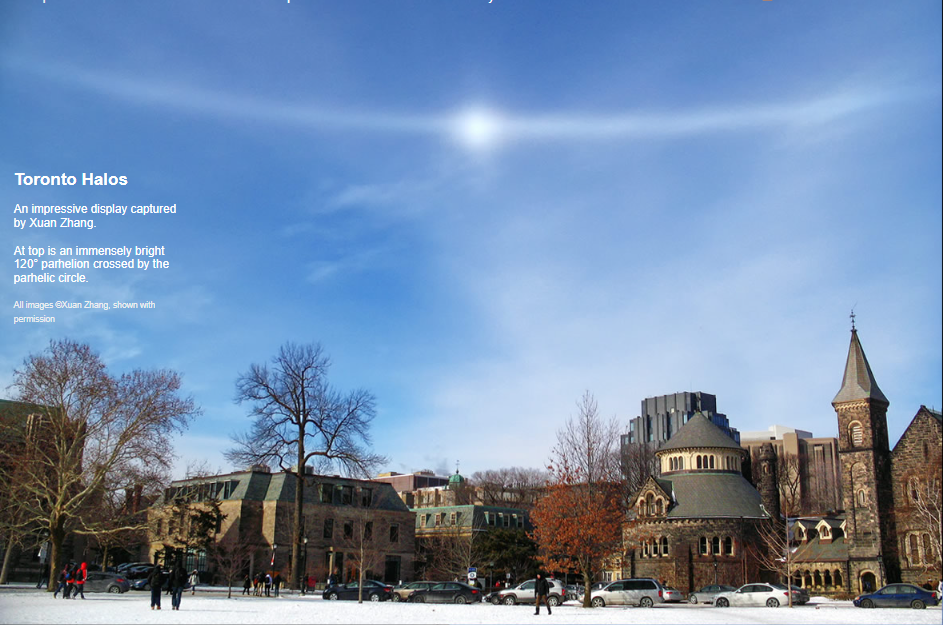
Toronto Halos
An impressive display captured by Xuan Zhang.
At top is an immensely bright 120° parhelion crossed by the parhelic circle.
All images ©Xuan Zhang, shown with permission
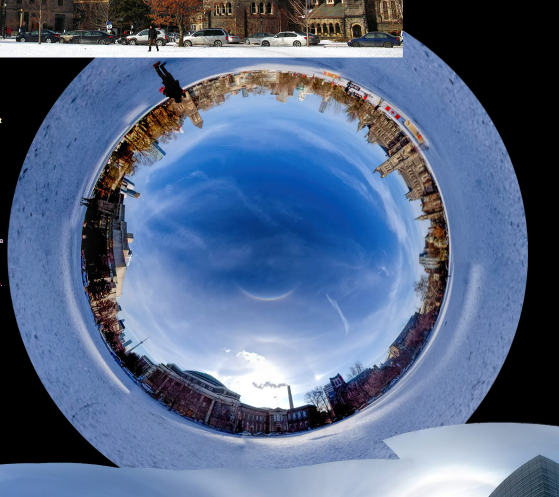
Plate crystals dominate. They generated most of the intensity of the parhelic circle, they produced the 22° and 120° parhelia and the circumzenithal arc overhead.
Randomly oriented hexagonal prisms of some kind made the 22 degree halo and the 46° halo fragment (it could instead be a supralateral arc). Horizontal columns were in the minority giving a weak and indistinct upper tangent arc.
120° parhelion
Plate crystals with their large hexagonal faces nearly horizontal yielded the amazingly bright 120° parhelia on the parhelic circle.
In one possible ray path sunlight enters a top face, internally reflects twice and leaves through the lower face. The entrance and exit angles are equal and there is no net dispersion into colours - the 120° parhelion, unlike the 22° parhelion, is white.
Bright 120° parhelia need thick plates or ones of triangular aspect 9alternate long and short side faces).
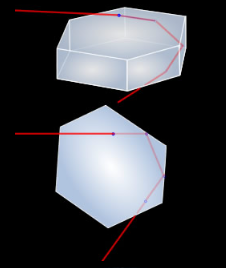

Aficionados of the UofT campus (and of halos) will want to scroll this large panorama to the right.
The projection nicely portrays the parhelic circle as parallel to the horizon.
Note the elusive 'blue spot' on the parhelic circle to the left of the left hand 120° parhelion and to the right of the RH one. This is where total internal reflection ceases, first for red rays and then for blue.
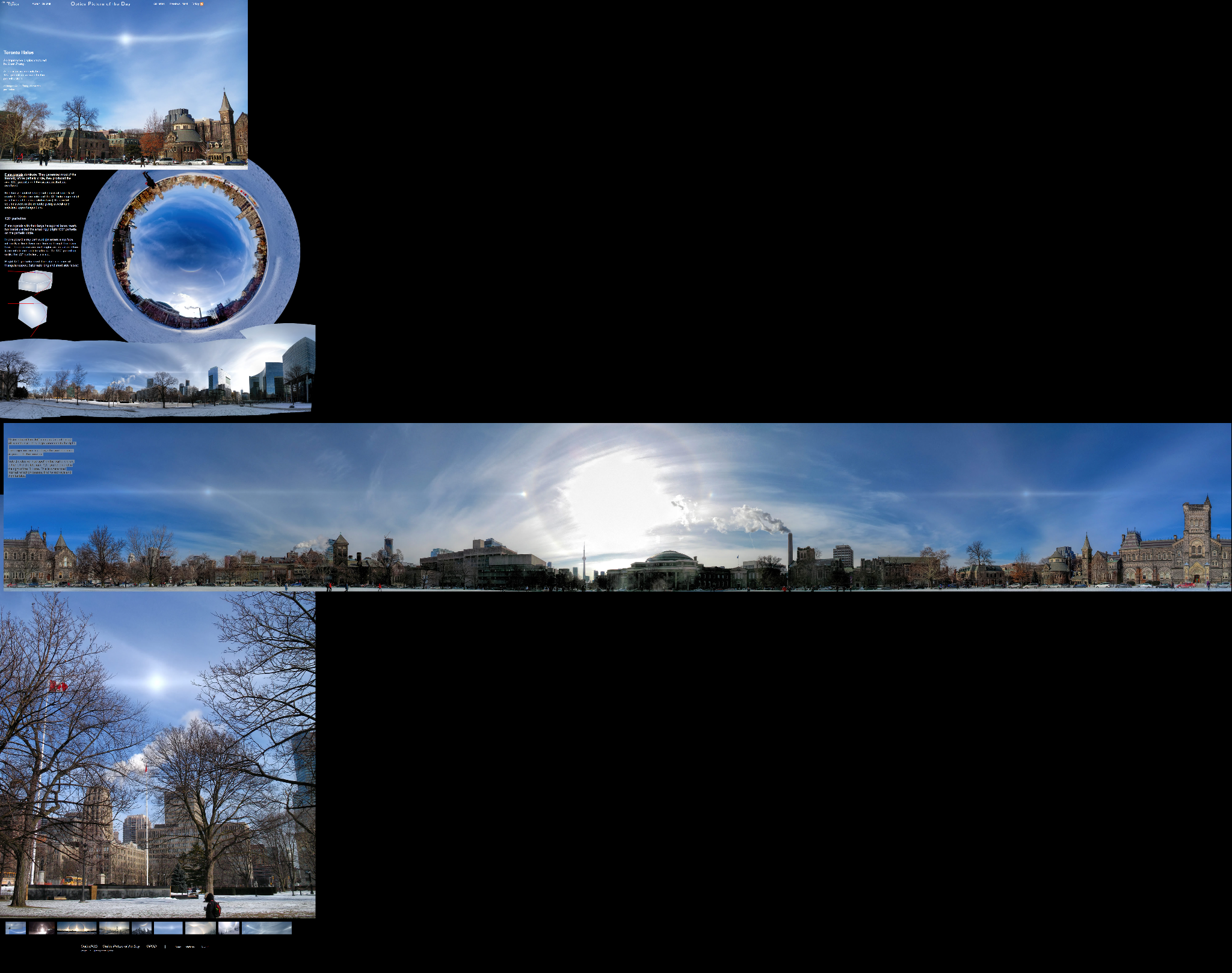
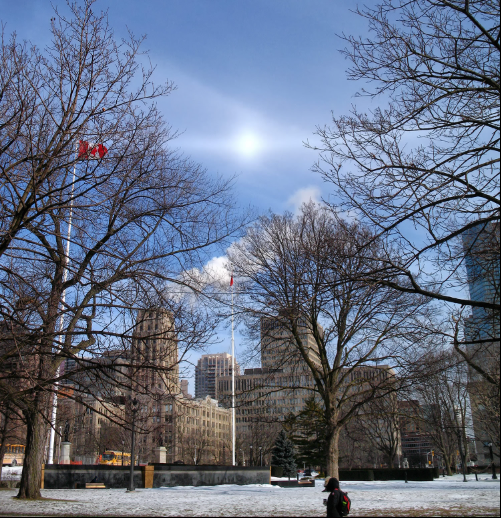
Note: this article has been automatically converted from the old site and may not appear as intended. You can find the original article here.
Reference Atmospheric Optics
If you use any of the definitions, information, or data presented on Atmospheric Optics, please copy the link or reference below to properly credit us as the reference source. Thank you!
-
<a href="https://atoptics.co.uk/blog/toronto-halos-opod/">Toronto Halos - OPOD</a>
-
"Toronto Halos - OPOD". Atmospheric Optics. Accessed on November 21, 2024. https://atoptics.co.uk/blog/toronto-halos-opod/.
-
"Toronto Halos - OPOD". Atmospheric Optics, https://atoptics.co.uk/blog/toronto-halos-opod/. Accessed 21 November, 2024
-
Toronto Halos - OPOD. Atmospheric Optics. Retrieved from https://atoptics.co.uk/blog/toronto-halos-opod/.